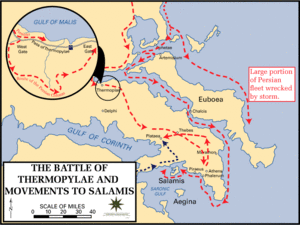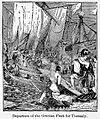Battle of Artemisium facts for kids
Quick facts for kids Battle of Artemisium |
|||||||
|---|---|---|---|---|---|---|---|
| Part of the Greco-Persian Wars | |||||||
 Map showing major incidents of the second Persian invasion of Greece |
|||||||
|
|||||||
| Belligerents | |||||||
| Greek city-states | Persian Empire | ||||||
| Commanders and leaders | |||||||
| Eurybiades, Themistocles, Adeimantus |
Artemisia I, Achaemenes |
||||||
| Strength | |||||||
| 271 ships | 800 ships | ||||||
| Casualties and losses | |||||||
| ~100 ships lost or damaged | ~200 ships lost | ||||||
The Battle of Artemisium was a major naval (sea) battle. It happened in 480 BC. This battle took place at the same time as the famous Battle of Thermopylae on land. Both battles were part of the Greco-Persian Wars. These wars were fought between the Greek city-states and the powerful Persian Empire.
| Top - 0-9 A B C D E F G H I J K L M N O P Q R S T U V W X Y Z |
What Was the Battle of Artemisium?
The Battle of Artemisium was a series of naval clashes. It happened near Artemisium, off the coast of Euboea. The Greek fleet tried to stop the huge Persian navy. This battle was very important for the overall war strategy.
The Persian Fleet's Journey
The Persian navy was enormous, with about 1,200 ships. As they sailed towards Artemisium, a terrible storm hit them. This storm was off the coast of Magnesia. The Persians lost about one-third of their ships.
After this, the Persians sent 200 ships around Euboea. They hoped to trap the Greek fleet. But another storm struck these ships. All of them were shipwrecked. These storms greatly weakened the Persian navy.
The Main Sea Fight
The main part of the battle lasted for two days. There were many smaller fights before that. Both sides fought very bravely. They both lost a similar number of ships.
However, the Greek fleet was much smaller. They could not afford to lose many ships. The Persian fleet was still much larger, even after the storms.
Why the Greeks Left
After the fighting, the Greeks got bad news. Their army had been defeated at Thermopylae. The Greek plan was to hold both Thermopylae and Artemisium. With their losses and the army's defeat, the Greeks decided to leave.
They sailed away to Salamis. The Persians then took over Boeotia. They also captured Athens, which had been emptied. Later, the Persians wanted a big win against the Greek fleet. But they were defeated at the Battle of Salamis later in 480 BC.
Images for kids
-
Site of the Battle of Artemisium (center). The location of the Battle of Thermopylae appears in the lower left corner.
-
The Ionian fleet, here seen joining with Persian forces at the Bosphorus in preparation of the European Scythian campaign of Darius I in 513 BC, was part of the Achaemenid fleet at Artemisium. 19th century illustration.
-
Sketch reconstruction of a Greek Trireme
-
Disaster to the Persian fleet off Euboea's eastern shore.
-
Euboea's eastern shore, the "Hollows", where a large part of the Achaemenid fleet was shipwrecked.
See also
 In Spanish: Batalla de Artemisio para niños
In Spanish: Batalla de Artemisio para niños










